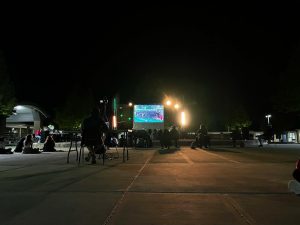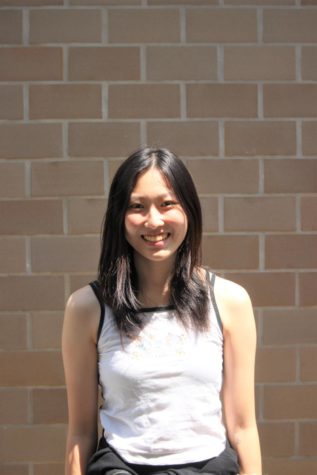The false nature of social media renders homecoming asks more complex than posters and flowers
The intersections of social media and homecoming ask culture have impacted the “acceptable” demonstration of teenage relationships.
September 26, 2021
The elusive homecoming proposal. The ultimate public declaration of love, or maybe just friendship in high school. I don’t know how many times I’ve walked down the halls mid-September to early October hearing shouts and seeing crowds with phones raised to post stories of “the lucky couple.” I never understood the idea that the guy should make the poster or why an ask was even expected for couples. But looking at the big picture of society, a poster and flowers would bring a lose-lose situation for me: publicity and judgment that could ruin joy while privacy creates doubt of the pride of being in a relationship.
As this homecoming season passes by, this culture rapidly starts up, but what is the context behind these dances and asks anyway? Supposedly, it all started with the Dallas Morning News dubbing a 2001 ask over a loudspeaker as the “promposal.”
“The paper was commenting on what was, at the time, a charming new phenomenon. Kids were asking each other out to prom over the loudspeaker! They rewrote the words to Adam Sandler’s song in ‘The Wedding Singer’!” Caitlin Dewey of the Washington Post explained.
What’s the justification for this new form of public asking? According to Dewey, a student rep stated, “Our generation loves doing it bigger and better and prom is one event where you can get to really show off — your date, your clothes.”
This kicked off a variety of these extravagant asks, such as trails of rose petals and billboards plastered on the road, which all shared the same theme: a fresh and rewarding celebration of pure love.
“The next prom proposal story doesn’t show up until a full year later, in 2002, but there’s a torrent after that. Boys in Arizona leave trails of rose petals from their dates’ houses to the school. A young man in Idaho somehow sneaks an alarm clock into his girlfriend’s room, where it rings at 3 a.m. and displays a message “Hope it’s not too late — will you go with me to the prom?” Dewey mentioned.
The birth of video-sharing sites such as Youtube helped bring this movement to national focus, as crowds of people online gathered under the tag “promposal”.
“YouTube is the true home turf of the promposal . . . There are currently more than 40,000 videos tagged ‘promposal’ and an additional 900,000 tagged ‘prom proposal’ or ‘ask cute,’” Dewey explained.
“Promposals are ‘marriage proposals for high schoolers,'” a 20 year old man told Lisa Bonos of the Washington Post.
The practice even evolved, even past promposal to dances from homecoming to Sadie Hawkin’s. By using the wide stretches and power of the Internet, people acquired fame from asking out celebrities, giving elaborate presents such as dogs or shoes and crazy posters relating to puns.
“The promposal appears to be all for the ‘gram and the public glory. There are countless social media accounts devoted to capturing those ‘she said yes’ moments. MTV even had a reality show called ‘Promposal,’” Bonos explained.
These additional efforts of wooing attracted millions of people but in my opinion, rendered the original theme and purpose as afterthoughts. They don’t need to come together like a package deal: posters can be posters, and relationships can be relationships.
“People only see the ‘beautiful’ aspect of a relationship rather than the raw connection between two people. Love and connection doesn’t only occur between two people in a relationship, but also between friends,” a female student explained.
Take Dougherty culture as an example. Homecoming is much less “hyped” as prom is, but public homecoming asks are pretty normalized, especially for couples. Similarly, videos are quickly uploaded on apps such as Snapchat, sparking conversations across each class around questions such as, “Did you see that homecoming ask?”
“I think it’s just excitement around the whole ‘hoco’ ask culture that circulates around our school that kind of just makes them more interesting,” a male student attending Dougherty Valley High School explained.
It’s pretty expected that couples would ask each other, whether publicly or privately.
“It’s kind of a given that you guys [couples] are going to go together, so I don’t know if it would necessarily have to be private,” he explained.
But why is one highlighted while the other stays in the shadows? Well, it’s hard to document something when tens of people aren’t watching. Because of the dominance of social media and its connections across campus, it creates an illusion that since most couples are being asked publicly, one must conform to gain acceptance or validation. Just as we have lingering assumptions, such as thinking one partner is embarrassed by the other because they hide them on social media, the homecoming proposal can also be used to secure the authenticity to others as much as the couples themselves.
This can bring about anxiety for both sides. Of course, there is the obvious perspective of the “asker.”
“There are a lot more societal expectations from a public one, both on the girl and the guy, especially because the guy tends to have to go “all-out” and do a cliche proposal,” a female student corroborated.
At our school, making a whole poster can take a 5-man team hours, and the pressure of mustering up the courage during the right moment can take weeks. Less highlighted is the receivers’ anxiety, who are left waiting for “something special,” and the sadness many feel with not being “highlighted.”
“It was slightly awkward hearing about how people were envious or just gossiping about it. People also came up to me saying how I was lucky,” she explained.
Many students also want to be asked for validation. Homecoming asks and promposals often get others to pay attention and almost envy what one has, and feel a similar conformity of needing to be asked as the receiver to the asker needing to propose in the first place.
“What if someone doesn’t get a promposal or gets rejected in public? High school is hard enough; why add another measure of popularity to the daily struggle?” Bonos corroborated.
On the other hand, many may prefer a private proposal where they can freely express their feelings with no pressure to say yes around a crowd and refuse in private. However, this is entirely hard to distinguish when proposals are supposed to be a surprise, “romantic” gesture.
Promposals may have started out between couples, but that doesn’t mean all dances, asks and “glory” are reserved for couples. Not all homecoming asks must be between couples; some would just like the experience of going with a date or just one slow dance before their high school experience ends. In the case of this male student, he simply asked a friend.
“We’re just going as friends and just for fun . . that’s like the whole element as to why I asked her to hoco . . . It’s also part of the process of an ask, hoco poster, flowers, taking pictures together and going together is just all part of the process to me . . . what the idealized version of what hoco should be for some people,” he explained.
Public proposals have a different meaning to everyone, whether there is a serious expectation for the hopeless romantic or unnecessary to those who abhor love.
“Generally, proposals are between actual relationships or people who like each other . . . to me, proposals are just a way to make someone feel special and loved, even as friends,” she explained.
To me, homecoming proposals are complex. They can be something simple, from a celebration with a poster and flowers to a serious matter, defining the start of a relationship and maybe, a future. There will always still be that wholesome aspect, where people start with intentions of publicly announcing their care of friends or partner, but social media creates pressure. Firstly, the expectancy of a proposal is just one example of society’s placement of conformity and acceptance as a step above genuine connection. But also, these scenes must be orchestrated and shot over and over again to seem perfect, and relationships aren’t any different.
With so many stories of public proposals going awry, these situations can be extremely uncomfortable for both sides of the party and it’s a priority to make sure they aren’t put through discomfort. However, no matter the person or situation, I believe all must have some form of consent.
“What I’ve been seeing recently even with some of my friends is to ask before,” he corroborated.
In this day and age, social media is all around us and we do have to embrace that. But if an ask is the true test of a friendship or relationship, there shouldn’t be qualms about asking a hinting question about preferences or straight up asking consent.
“That check-in might sound like: “Hey, would you like to go to prom with me?” Followed by: “Is it okay if I prompose? Do you want me to prompose?” Bonos explained.
Homecoming asks tie into the negatives and positives of what our society’s evolved into, from that serotonin rush of posting a video with a person you love or an acknowledging comment but also the hidden insecurities, doubt and judgments.
“The most romantic moments of a person’s life likely won’t involve puns on poster board. They’ll be the quieter moments that social media isn’t privy to,” Bonos explained.
Even if this is all meant to be fun, but not taking into consideration other’s feelings shouldn’t ruin the experience, much less trust of the relationship. Satisfaction doesn’t need to be achieved through perfection, planning or even a full-blown ‘ask.’ For some, consideration of preference may be enough.




